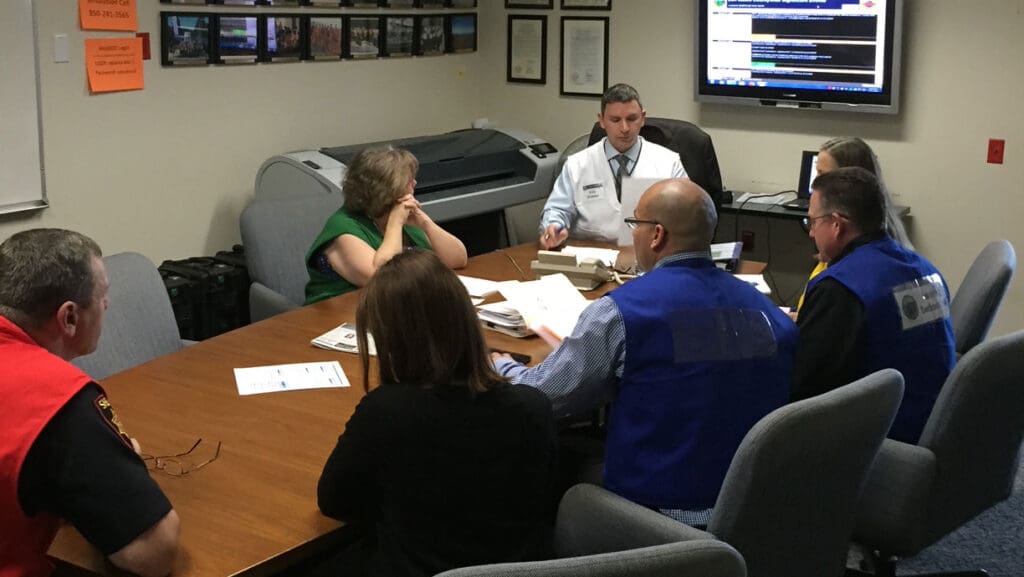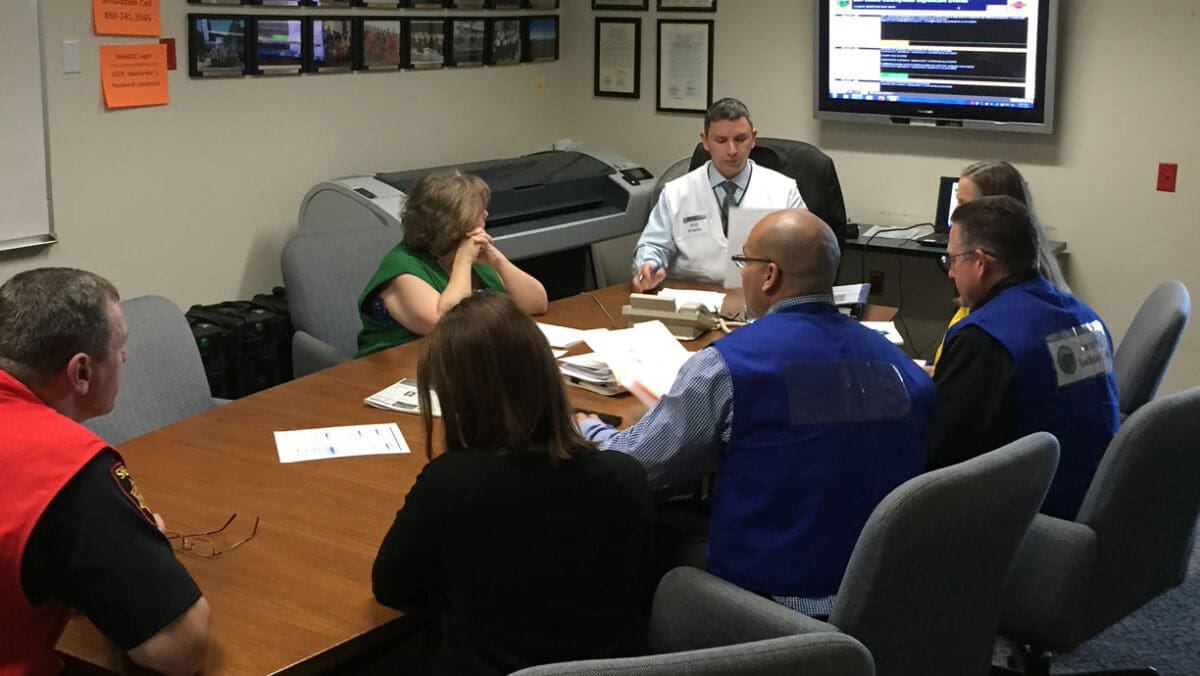
The term ‘first responder’ brings several images to mind: police officers, firemen, paramedics and other trained professionals. What most people don’t include in their imagery of a first responder is their coworker, their boss, their spouse, or the person worshipping next to them. Reality proves time and again that when a crisis of any type occurs, the true first responders are those who are at the scene when the incident strikes. Some of the most unsuspecting people who were forced to jump into first responder mode include those in houses of worship; data indicates 75% of people in the United States identify with a faith-based religion and attend a variety of religious services during any day of the week. With approximately 350,000 congregations nationwide (including churches, synagogues, mosques, and temples) the number of incidents within a religious congregation are staggering. the Lifeway Research data indicated that 67.3% of churches in the United States have a membership of 100 or less. Churches with a membership between 101-250 is 20.1%. The combination of medium-size and small-size churches in the United States is 87.4%! See the below list for the other groups.
Church population1
- 50 or less – 39.9%
- 51-100 – 27.4%
- 101-250 – 20.1%
- 251-1,000 – 9.9%
- 1,000+ – 2.6%
A recent report titled “Violence During Church Activities from 2019-2022”2 provides data showing a 50% increase in violent incidents in 2022 as compared to 2021: this indicates a nationwide violence surge is affecting houses of worship. Also on the rise is the number of deaths during these incidents, with 21 deaths in 2022 compared to only 6 deaths in 2019. Yet another report from Family Research Council claims a staggering 420 acts of hostility were made against churches between January 2018 and September 2022 in 45 states.
Churches face other, more probable hardships, such as flooding, power outages, natural disasters, medical emergencies, theft, vandalism, trespassers, threats and day-to-day incidents that any organization will have.
“If it is predictable, it is preventable;” while the old saying may not always ring true, houses of worship cannot deny the fact that they are often victim to crime, along with a myriad of other incidents. Having proper planning in place can help both the leaders of the church and those attending and volunteering when it matters most. Listed below are only a few points proving the need for a carefully thought-out, all-encompassing emergency response plan:
- Safety of Congregants: The primary concern is the safety and well-being of the people who gather at the place of worship. Having an emergency response plan ensures that congregants and visitors are prepared for various types of emergencies, including natural disasters, medical emergencies, and security incidents.
- Risk Management: By identifying potential hazards and developing response plans, houses of worship can mitigate risks and minimize the impact of emergencies. This proactive approach can help prevent injuries, property damage, loss of life and lawsuits.
- Community Support: Houses of worship often serve as focal points for communities, providing not only spiritual guidance but also support during times of crisis; effective emergency response plans in place enable these institutions to better serve their communities and aid those in need during emergencies.
- Legal and Regulatory Compliance: In many jurisdictions, there are legal requirements or guidelines mandating that public buildings, including houses of worship, have emergency preparedness plans. Compliance with these regulations helps ensure that the institution meets its legal obligations and avoids potential liabilities.
- Protection of Assets: Houses of worship may have valuable assets, including historical artifacts, religious texts, and infrastructure. Emergency response plans help safeguard these assets and ensure their preservation during emergencies such as fires, floods, or vandalism.
- Maintaining Continuity of Operations: Disruptions caused by emergencies can impact the ability of houses of worship to carry out their regular activities and services. Having contingency plans in place ensures that essential operations can continue, even in the face of adversity.
- Training and Awareness: Conducting training exercises and raising awareness about emergency preparedness among staff, volunteers, and congregants enhances overall readiness and response capabilities, empowering individuals to take appropriate actions during emergencies and fostering a culture of safety within the community.
- Recovery: Financial, Psychological and Reputational recovery is at stake; be the example of how to survive and win against an adversary (weather, human or technological) rather than be an example of how to fall as a victim.
Emergency Response Plans, procedures, and training are essential components of responsible stewardship for houses of worship. Plans help protect lives, property, and the continuity of operations, while also fulfilling a broader mission of serving and supporting the community during times of need.
Emergency Response Plans (ERP) are the solution to a complex problem. Veteran owned Kearnan Consulting Group, comprised of various experts and experienced professionals, has spent over 2 years developing a series of plans based on Best Practices, FEMA regulations, Code of Federal Regulation, National Industry Standards, NFPA and regulatory authorities. The Emergency Operations Plan (EOP) will prepare and teach houses of worship to identify gaps, provide training, document incidents as well as have an overall sense of preparedness for all types of incidents. In tandem with the EOP are separate plans focused on specific user groups, that when combined with the EOP create an overall plan of success.
- The Emergency Operations Plan – The Policy, the “why we do things” plan developed specifically for executives, leadership, attorneys, and Insurance companies.
- The Emergency Response Plan – The user friendly, distilled version of the EOP for employees to follow during an emergency.
- The Reunification Plan – a guide to reunite children with parents and guardians.
- The Procedural Manual for Members of the Safety & Security Team – The “How to do my job” guide, along with job descriptions for each volunteer position.
- The Training Plan – The “How To” guide for planning, doing, and documenting training to be used to show due diligence during a claim or in court.
Opting for quality, essential plans is the logical decision for preparation, reducing risk, prioritizing safety, and countering threats. Such plans should be regarded as an investment rather than an overwhelming debt-causing expense. Compared to the value of protecting a congregation, defending a lawsuit, and protecting your reputation, the cost of KSG’s plans fall in line with attainable spending goals for all houses of worship, from mega to start-up.
In the event you do experience a critical incident, absent these tools, it will be difficult to rise to the occasion, but rather you will likely fall to your level of training and preparation. Don’t fall to the temptation of complacency. Jesus did not teach us to be complacent; “Behold, I am sending you out as sheep in the midst of wolves, so be wise as serpents and innocent as doves.” Matthew 10:16.
There are many biblical scriptures that inform us the need for security. Below are just a few.
- Isaiah 62:6 – “I have posted watchmen on your walls, Jerusalem; they will never be silent day or night. You who call on the Lord, give yourselves no rest.”
- Nehemiah 4:9 – “But we prayed to our God and posted a guard day and night to meet this threat.”
Although God assures us of protection, He also expects us to utilize the discernment granted by the Holy Spirit, which is available to all Christians, to make wise choices within our capabilities. Just as the ancient Jews, while relying on Elohim, took practical precautions to fend off attacks from their adversaries, we too should implement rational and sensible policies and plans to safeguard the congregants gathered at Your House of Worship from harm.
What measures have you taken for the safety of your congregants?
For more information regarding state-specific emergency operation plans and cost, go to https://kearnanconsulting.com/
Respectfully,
Jeffrey C. Kearnan
Kearnan Consulting Group, LLC
Church Security Solutions | Emergency Planning Consultant CA
Jeffrey C. Kearnan (jeffkearnan.com)
About Mr. Kearnan
Jeff Kearnan is a retired Assistant Sheriff, former director of Emergency Services, former Assistant Deputy Director of the Northern California Regional Intelligence Center, former USAF noncommissioned officer, holds degrees in Homeland Defense and Security Studies and Criminal Justice Management. Mr. Kearnan is a security consultant for a reputable church insurance company and owns a successful consulting firm that specializes in expert witness testimony in civil lawsuits involving negligence, premises liability, standard of care, and police practices and use of force cases. Mr. Kearnan is called upon to perform threat and vulnerability security risk assessments for houses of worship, corporations, and government infrastructures. Mr. Kearnan uses his training, education, and experience to help houses of worship stay safe by preparing and planning for predictable surprises in way of policy, procedure, training and response plan writing.


